I have been trading coins for 10 years, starting with 300,000 in the market, then losing over 1.2 million, and now living off trading coins, with over 35 million in my account!
I can say that I have used 85% of the methods and techniques in the market, but the most practical are the solid skills I have summarized. If you want to treat the coin circle as a second profession to support your family, you must study this article seriously, which will help you avoid 10 years of detours!
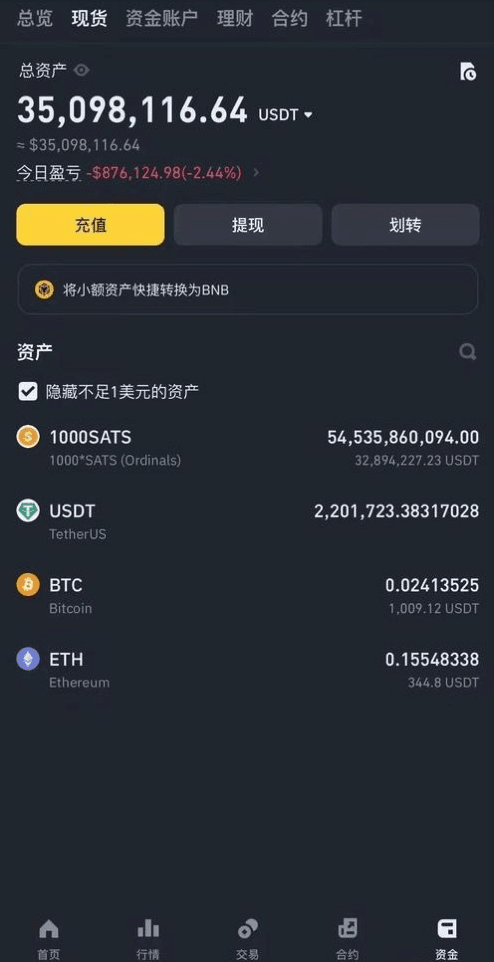
When trading reaches a certain level, it is about 'trying not to make mistakes'—not seeking victory.
In the end, as long as you do the right things in trading coins, the market will reward you with the profits you deserve. Some people cannot make money in the market, no matter how hard they study. This is not related to knowledge but because they are 'doomed' to be losers.
Great investors are those who are extremely obsessed with this game and have a strong desire to win. They do not just enjoy the fun of investing—investing is their life. They have a strong willingness to learn from past mistakes. This is difficult for people to achieve, and what sets great investors apart is this strong desire to learn from their past mistakes to avoid repeating them. The three-character classic of successful traders: restraint, determination, wisdom.
In trading, 'restraint' means: a gentleman does not stand under a dangerous wall; you must know what to do and what not to do. Weak water three thousand, only take one ladle; you must understand trade-offs, know contentment, and avoid worry about gains and losses. The capital market has no foreknowledge or regret medicine.
In trading, 'determination' means two aspects: once you choose your trading system and model, do not waver but operate according to your system. Secondly, the longer you use a theory, the deeper your understanding will be, and your heart will be more stable.
In trading, 'wisdom' means maximizing the use of a tool; the more you do so, the more you will understand the nuances of this trading method and skills, greatly enhancing your overall ability to navigate market transactions.
Having ideas and strategies reveals value. Learning is for better progress, thereby enhancing one's ability and insight.
So how can we excel in trading coins? Once a person enters the financial market, it is difficult to turn back. If you are currently at a loss and still confused, planning to treat trading coins as a second profession, you must know the 'naked K trading strategy.' Understanding and comprehending it can help you avoid many detours, based on personal experiences and feelings, I recommend saving and repeatedly pondering!
After years of trading with naked K lines, I've condensed the nine-character essence: identify trends, find turning points, wait for signals.
Identify trends
Trend represents direction; once a trend is formed, it will not be easily changed in the short term, especially in the medium to long term. A trend is also a state of price movement; identifying trends means clarifying our trading direction.
There are only two types of trends:
Rising lows and highs indicate an upward trend, primarily focusing on going long.
Lowering lows and highs signifies a downward trend, primarily focusing on going short.
Note: Consolidation is a trendless state of movement, waiting for a breakthrough.
Find turning points
A turning point refers to a location; finding turning points is about identifying key levels for trend continuation or reversal. These key levels are generally horizontal support and resistance levels or trend line support and resistance levels.
Wait for signals
Waiting means patiently waiting.
Signals include hammer lines, inside bars, engulfing lines, and trend K lines.
Analysis and trading steps: Identify trend - Find turning points - Wait for signals
Step 1: Identify the current price trend direction through structure.
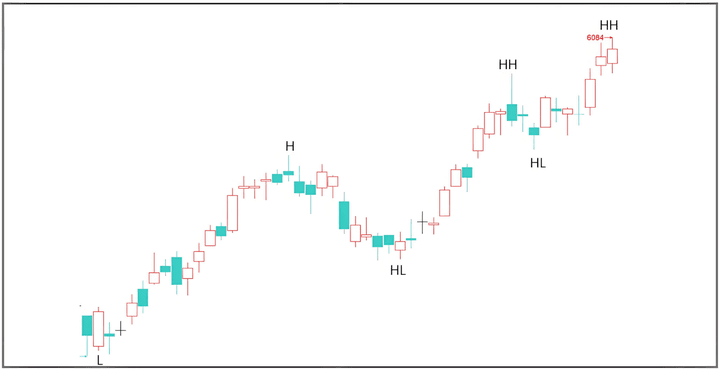
Figure (1)
Higher lows and higher highs indicate an upward structural trend, primarily focusing on going long.
Step 2: Find price support and resistance levels, draw horizontal or trend lines to find turning point locations.
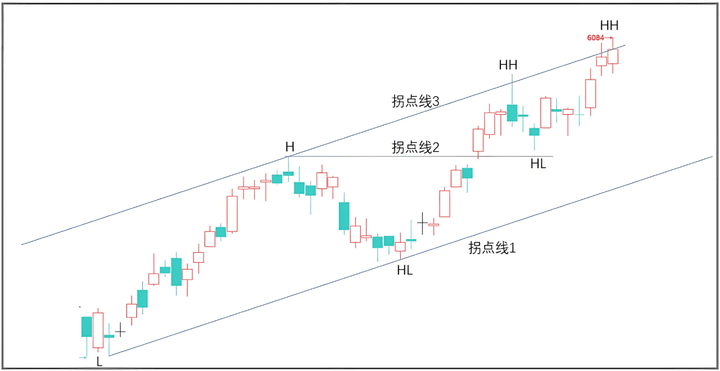
Figure (2)
Turning point line 1: It is an ascending trend line established by two low points, acting as support. If the price retests it and stops falling, it is a good time to go long; if it breaks below, the original trend may change.
Turning point line 2: The horizontal resistance level at the wave high point, which acts as resistance. If the price breaks through it, it signals the establishment and continuation of an upward trend, while the resistance level turns into a support level. If the price retests and rebounds after breaking through, it is a good time to go long.
Turning point line 3: It is the rising channel line based on the rising trend line (turning point line 1), which acts as resistance. If the price touches it, it may face resistance and fall back. If it breaks through, it signals accelerated price increase, primarily serving as a target reference for wave rises in the upward trend.
Step 3: Patiently wait for the breakthrough signal or the breakthrough retest signal at the turning point.
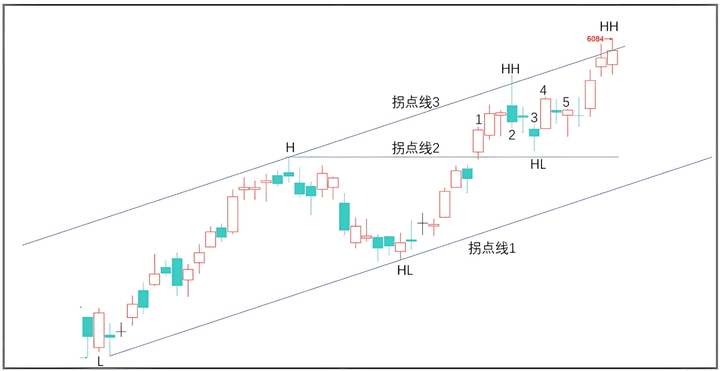
Figure (3)
K1 is a trend K line entry signal that breaks through the resistance of turning point line 2 with a gap up.
K2 is a bearish hammer line suppressed by turning point line 3, signaling to take profit on the wave.
K3 is a stop loss signal that tests support at turning point line 2 after price breaks through.
K4 is a trend K entry signal indicating a rise after stopping the decline.
K5 is a buy signal in a small hammer line that tests support at turning point line 2.
Generally speaking, the more technical indicators you master, the more complex they are, the easier it is to be arranged by the market. I will continue to share how to trade using a price chart, commonly known as 'naked K trading'; at the same time, I will add the Exponential Moving Average (EMA) as an auxiliary parameter to further understand trends.
The following content is aimed at 'beginner investors' in the secondary coin market. It assumes they do not have enough time to monitor the market constantly, have asymmetric information, and react slowly, do not understand various technical indicators, lack good market sentiment, and do not have enough patience but are addicted to trading... The following content is specifically designed to address these 'symptoms' and hopes to have a profound effect.
The example provided is also the daily K line chart of BitMEX's perpetual Bitcoin contract XBTUSD. The reason for using a relatively large time frame like the daily K is that it can more accurately reflect market conditions. If the time frame is too small, it is easy to produce false trading signals. Compared to intraday short-term trading, day trading does not require constant monitoring, reducing operation frequency and allowing profits to grow more healthily in a long-term trend.
Before sharing several price actions that serve as entry signals, we must first understand two concepts.
1 Support and Resistance Levels (S&R Levels)
Support and resistance levels are very important concepts. As the name implies, support is a price level where there is support; resistance is a price level where there is pressure. Note that these two are constantly changing. Because the trading signals exhibited at these two positions are much more successful than those emitted at other positions, we must learn to identify S&R in the chart. Meaningful S&R will show clear signals on the daily chart.
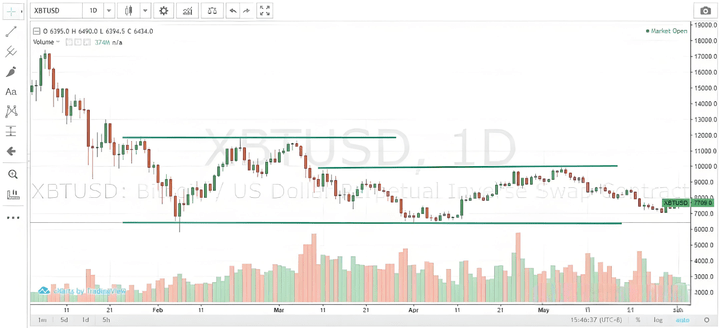
2 Trend (Trend)
Divided into upward trends and downward trends. An upward trend refers to a situation where the high points of prices are getting higher and the low points continue to rise. Conversely, in a downward trend, the suitable opportunity to build positions is at the confirmed low point during price pullbacks; in a downward trend, the suitable opportunity is at the confirmed high point during price rebounds.

Below, we formally introduce several commonly used price action setups, providing clear entry signals before a trend starts, including entry price and stop loss price, to achieve superior risk-reward ratios.
1
Rejection Candle
Rejection candles, also known as pin bars, include hammer lines and inverted hammer lines. When the price is supported or pressured at a certain position, a K line is formed with a very small body and long shadows at closing. In this price action, a pin bar with a long lower shadow is a buy signal; conversely, a pin bar with a long upper shadow is a sell signal.
The effective conditions for the above conclusions to hold are that they occur at strong support & resistance positions, at clearly trending moving average positions, at clear boundaries of consolidation zones, and on clearly effective trend lines; if the overall length of the pin bar is too short, it cannot serve as an effective trading signal.
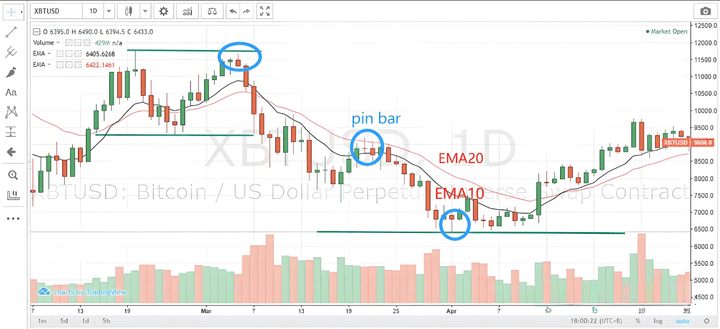
2
Double K Reversal (2 Bar Reversals)
Double K reversal consists of two long K lines with sufficiently large bodies and very short or no shadows. A long bearish candle followed by a long bullish candle serves as a buy entry signal; the opposite is also true. The entry signals here are similar to the efficient conditions of pin bars, where both patterns appear at critical locations (main support & resistance levels, moving average positions, trend lines, etc.).

3
Engulfing Line (The Outside Bar)
The engulfing line is a special case of the double K reversal, consisting of two opposing K lines, but the second K line must completely wrap around the first K line, meaning the entire body of the latter wraps the former. The entry requirements for this reversal signal are similar to the previous two price patterns.
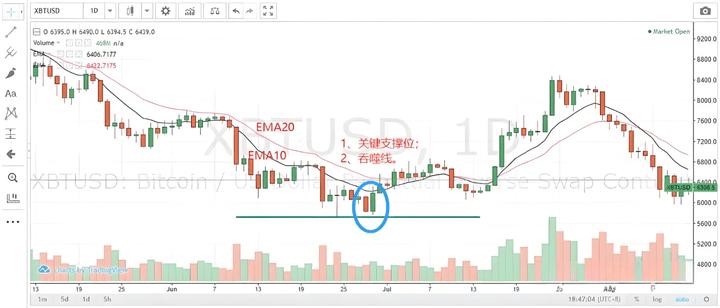
4
Consolidation Rhythm
Consolidation rhythm indicates that the price trend is in a non-directional consolidation state within a certain time frame, but this state can be broken at any time. In this case, the best trading strategy is to refrain from trading. We need to patiently wait for the market to indicate a breakthrough direction. The longer the consolidation period, the stronger the breakout trend.
Many investors suffer from 'trading addiction,' frequently trading within a consolidation range, possibly making small profits, but when a breakthrough forms a trend, they miss out on larger profit opportunities. We should be seasoned hunters, not reckless butchers.
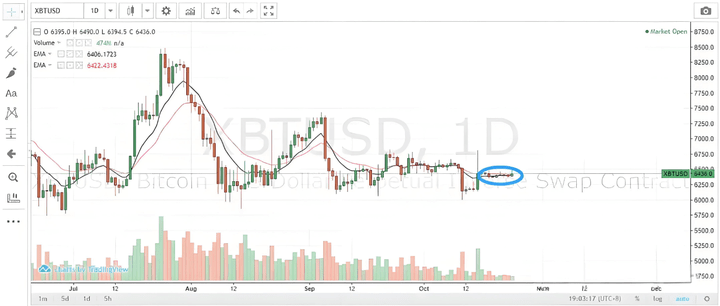
5
Inside Bar (The Inside Bar)
The inside bar refers to a price action where the latter K line is wrapped by the former K line. The K lines refer to the overall structure, including the body and upper and lower shadows (even if the body of the subsequent K line is not wrapped by the body of the previous K line).
The best inside bar signal is a breakout that follows the original trend direction. It is usually viewed as a continuation pattern. If the inside bar signal appears at key support and resistance positions, it can serve as a signal for price movement stagnation. The closing direction of the inside bar typically indicates the direction of the upcoming breakout.
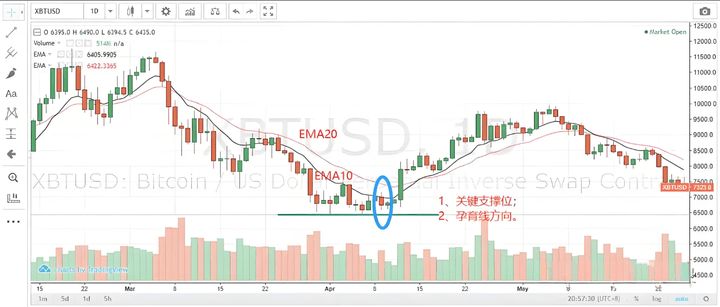
The analysis method of the doji star is similar to that of the inside bar and will not be elaborated here.
This article is a personal summary of part of (The Price Action Protocol) (this book was recommended to me by a major short seller in the digital currency space, for which I express gratitude!) and a review of Bitcoin's daily K line chart. If readers are interested in further study, they can search online to obtain more information on naked K price action trading, trends, etc.
Speculative trading in the coin market is not a simple matter. Besides knowing how to enter, it is more important to understand how to manage funds. Position size, risk-reward ratio, etc., should be included in the investor's trading system. All roads lead to Rome; a small throw of a brick hopes to inspire.
Finally, let me share a set of ironclad battle rules! Easy to understand for beginners.
1. For strong coins, if they fall continuously for 9 days at a high position, be sure to follow up promptly.
2. If any coin rises for two consecutive days, be sure to reduce your position promptly.
3. If any coin has risen more than 7%, there is still a chance to rise the next day; you can continue to observe.
4. For strong bullish coins, be sure to wait until the pullback is over before entering.
5. If any coin experiences three consecutive days of dull fluctuations, observe for three more days; if there are no changes, consider switching.
6. If any coin fails to regain the previous day's cost price the next day, exit promptly.
7. If a coin appears on the gainers list three times, there will be five; if there are five, there will be seven. Coins that have risen for two consecutive days should be entered at lower prices, and the fifth day is usually a good selling point.
8. Volume and price indicators are crucial; trading volume is considered the soul of the coin circle. When the coin price breaks through the low position of consolidation with high volume, it needs attention. If high volume appears at high positions with stagnation, exit decisively.
9. Only choose coins that are in an upward trend to operate, as this maximizes your chances without wasting time. When the 3-day line turns upward, it indicates a short-term rise; when the 30-day line turns upward, it means a medium-term rise; when the 80-day line turns upward, it indicates a major upward wave; when the 120-day moving average turns upward, it indicates a long-term rise.
10. In the coin circle, small funds do not mean no opportunities. As long as you master the right methods, maintain a rational mindset, strictly execute strategies, and patiently wait for opportunities to come, you can also achieve wealth in this land full of opportunities.
Remember, while the circle is good, the risks are also significant. Only by continuously learning, summarizing experiences, and constantly improving oneself can one go further!
The above are trading insights from ten years of trading coins, having experienced many ups and downs. These are heartfelt words of profound understanding, hoping they will be useful to everyone. The products from Yan An are certainly exquisite, and there are beautiful people in the coin circle, unique and independent, with a soulful approach to currency and skill!
No matter how diligent a fisherman is, he will not go out to sea during a storm but will carefully protect his fishing boat. This season will eventually pass, and a sunny day will come! Follow me, and I will teach you how to fish and how to fish sustainably. The door to the coin circle is always open; only by going with the flow can you lead a life of ease. Save this and keep it in mind!